How To Measure If Your Floor Is Sloping, Level Or Sagging: When Serious?

Homeowners and buyers often think that their floor is sloping, not level or sagging, but they’re not sure and do not know how much it is sloping. In order to help determine this and how serious things are, it is important to know how much the floor is sloping, where it is sloping (one room, a hallway, or the whole house) and in what direction.
Ways of checking if the floor slopes

Golf ball, marble or steel bearing
Home inspectors will often carry a marble or golf ball with them and if they suspicion that the floor slopes, they take out their golf ball or marble and lay it on the floor. If it rolls away, that indicates that the floor is not level; the faster that it rolls, the greater the slope in many cases. This method does not work well on carpeted floors or ceramic tile floors. Another problem with this method is that it doesn’t tell you how great the slope is, i.e. is there a 3/8 inch or 2-inch difference in 10 or 20 feet.
Levels
There are short torpedo levels, there are 3 foot long levels, there are 6 foot long level, etc. that will help you determine if there is a slope in the floor. At times a short level laid on top of a long 2×4 will help measure a longer distance.
A good rule of thumb is that the longer the level the better, because a short 9 inche level won’t give you as good a picture about the levelness as a six foot level.

Laser levels
There are a number of laser levels that project a beam for a long distance and can be purchased at the big box stores or on Amazon. These levels are easy to use and make measuring relative easy. They also are handy for checking drainage slopes around the home and hanging pictures.
Ideally, self-leveling levels are quicker and provide you a more accurate measurements than using non self-leveling ones. They’re also difficult to get set up properly, especially if you need to move them around the home to get different measurements.
For most homeowners who want to check all the floors in their home and get an accurate picture of their floors’ levelness, a self-leveling laser level is probably the best choice and will probably cost between $40 to $100 for one that will do a good job.
Top Rated Laser Levels and Cost
Phone level Apps
There are a host of apps for your phone that help tell if something is level. People use them for hanging pictures, checking if a counter top or table is level and a few use them to help determine if a floor is level. These apps can be purchased and there are many that are free online.
One of the drawbacks of using a phone app is that it only tells you if the small area that the phone is setting on is level. Although this gives you an indication, it is better to know if a 5,10 or twenty foot area is level; that is why a long level or a laser beam type level gives more accurate and meaningful information.
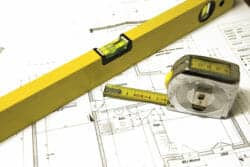
If checking the whole house, use a layout a grid
Create a floor plan showing 5-foot increments, then write the elevation at each of these points as you measure. Doing this gives you a much better picture of where the floor slopes and how much; valuable information when diagnosing the seriousness of a sloping floor.
The Pyramids and Professionals

Many scientist and historians often theorize on how the Pyramid builders got the bases so level. The general consensus appears to be that they used water. That small channels were dug in a grid pattern and filled with water and since water is perfectly level at all points, they could get the base perfectly level by measuring up from the water level.
Professionals often use a Water Level Manometer to conduct a floor levelness survey. Like the pyramid builders, it uses water, but instead of it being in trenches, it is usually in clear plastic tubes, similar to a clear plastic hose. The plastic tube or tubs are generally connected to movable tripods that hold the tubes in place and have a measuring rule or a method to measure the water level in the tube. These tripod stands are then moved from room to room with one that remains in a permanent location. The one that remains in the permanent location is used as the baseline from which all other measurements are taken.
Engineers may use a water level manometer but often use sophisticated laser levels or transits to do a level floor survey. Civil engineers and companies that specialize in OCE surveys and documentation of floor levelness and elevations are often called upon when serious problems develop or if there is litigation.
Homeowners will sometimes take a regular hose, put a clear 2 foot plastic hose on each end, and use it to measure the levelness at different locations, always keeping one end of the hose in the same location as a reference point. This is the same concept that the great pyramid builders used.
Check for an OCE

When a home is first built, some builders may have a floor and foundation survey done. These types of surveys are often referred to as an ORIGINAL CONSTRUCTION ELEVATION (OCE) survey.
If there was an OCE and you can obtain a copy of it, then you can compare the levelness of the floor now to how level the floor was when the home was first construction. (Read more on OCE’s)
Warning signs of seriousness
- If the floor is out of level 1 inch plus in 20 feet, depending on other factors
- If the sloping is getting progressively worse
- If there’s existing structural damage that may impact the floors
- If there are soil issues such as settling, slope creep, mining subsidence, sink hole activity or erosion issues
- If there’s extensive wood rot and deterioration, especially of main supporting beams and post
Diagnoses the seriousness of sloping involves more than just how much the slope is, therefore it is wise to examine other factors in addition to the slope itself.
Bottom Line
It is easy to tell if a floor slopes. A small slope is not unusual and is generally not much of a concern. Determining the significance of a sloping floor requires knowing where it slopes and how much; additionally, it would be wise to determine if it was built that way. If not built that way, then what caused the sloping and are there any structural issues relating to the sloping.
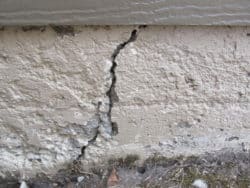
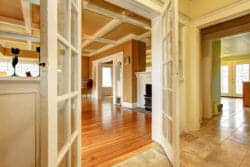
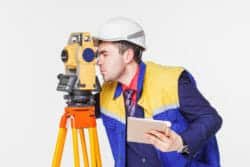
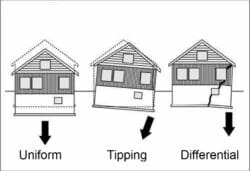



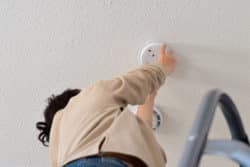


I live in a second story apt. The floor was sloped when i moved in 6 months ago. Recently i have noticed the floor is sinking eg. appliances moved slightly, cracks in walls, floor in 3 different rooms have dropped more. Do i need to worry or contact management?